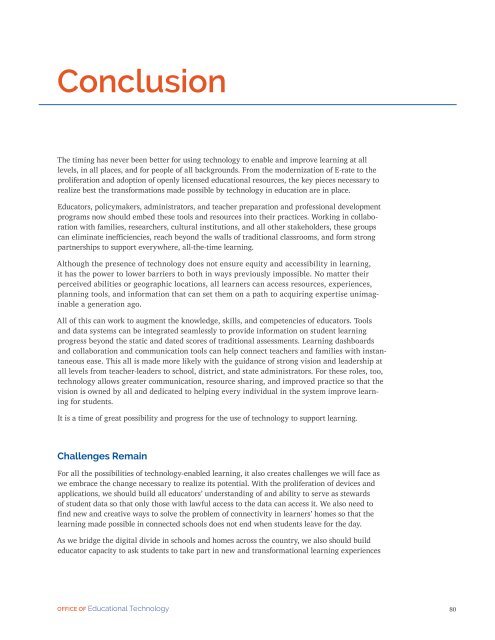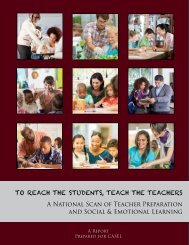Future Ready Learning
7m3sdJ
7m3sdJ
You also want an ePaper? Increase the reach of your titles
YUMPU automatically turns print PDFs into web optimized ePapers that Google loves.
Conclusion<br />
The timing has never been better for using technology to enable and improve learning at all<br />
levels, in all places, and for people of all backgrounds. From the modernization of E-rate to the<br />
proliferation and adoption of openly licensed educational resources, the key pieces necessary to<br />
realize best the transformations made possible by technology in education are in place.<br />
Educators, policymakers, administrators, and teacher preparation and professional development<br />
programs now should embed these tools and resources into their practices. Working in collaboration<br />
with families, researchers, cultural institutions, and all other stakeholders, these groups<br />
can eliminate inefficiencies, reach beyond the walls of traditional classrooms, and form strong<br />
partnerships to support everywhere, all-the-time learning.<br />
Although the presence of technology does not ensure equity and accessibility in learning,<br />
it has the power to lower barriers to both in ways previously impossible. No matter their<br />
perceived abilities or geographic locations, all learners can access resources, experiences,<br />
planning tools, and information that can set them on a path to acquiring expertise unimaginable<br />
a generation ago.<br />
All of this can work to augment the knowledge, skills, and competencies of educators. Tools<br />
and data systems can be integrated seamlessly to provide information on student learning<br />
progress beyond the static and dated scores of traditional assessments. <strong>Learning</strong> dashboards<br />
and collaboration and communication tools can help connect teachers and families with instantaneous<br />
ease. This all is made more likely with the guidance of strong vision and leadership at<br />
all levels from teacher-leaders to school, district, and state administrators. For these roles, too,<br />
technology allows greater communication, resource sharing, and improved practice so that the<br />
vision is owned by all and dedicated to helping every individual in the system improve learning<br />
for students.<br />
It is a time of great possibility and progress for the use of technology to support learning.<br />
Challenges Remain<br />
For all the possibilities of technology-enabled learning, it also creates challenges we will face as<br />
we embrace the change necessary to realize its potential. With the proliferation of devices and<br />
applications, we should build all educators’ understanding of and ability to serve as stewards<br />
of student data so that only those with lawful access to the data can access it. We also need to<br />
find new and creative ways to solve the problem of connectivity in learners’ homes so that the<br />
learning made possible in connected schools does not end when students leave for the day.<br />
As we bridge the digital divide in schools and homes across the country, we also should build<br />
educator capacity to ask students to take part in new and transformational learning experiences<br />
OFFICE OF Educational Technology<br />
80



